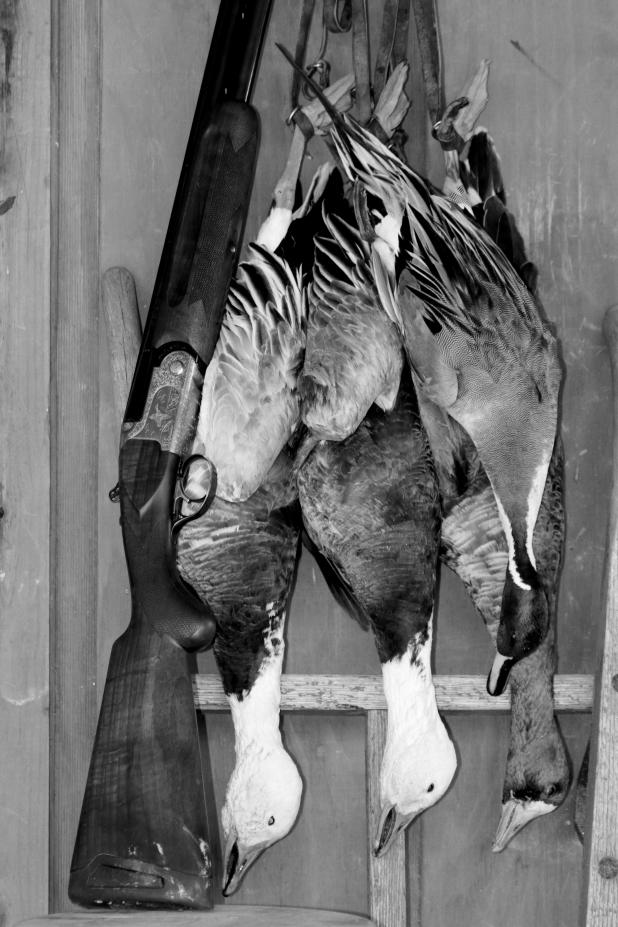
The coastal zone waterfowl season begins Saturday.
(Submitted Photo/John K. Flores)
Coastal zone duck season set to open Saturday
In case you haven’t noticed, for the past few weeks there have been a lot of trucks towing boats with surface drive motors up and down U.S. 90 stacked with various organic materials to brush duck blinds.
I suspect many of these hunters are making the long trek either down the Atchafalaya River or via the Wax Lake outlet to get to the Atchafalaya Delta Wild-life Management Area. And why not? The coastal zone first split of duck season will open Saturday.
For elementary school math teachers looking for a great story problem on how to learn the time of day, try this.
“Little Johnny’s dad is taking junior duck hunting. Legal shooting light is 30 minutes before sunrise. Sunrise is 6:29 a.m. What time can Johnny start shooting ducks Saturday?”
I guarantee if the teacher has any hunters in the class, the teacher will have their undivided attention for at least one problem.
The bigger question is will there be any ducks in suffi-cient amount to shoot when the season begins?
Last year’s (2018) U.S. Fish and Wildlife Service Breeding Population and Habitat Survey indicated there were 41.19 million ducks counted. And though the breeding numbers were down slightly from 2017, ducks were still 10 % above the long-term average.
In mid-August, the U.S. Fish and Wildlife Service released this year’s survey. The 2019 total breeding duck numbers declined for the second year in a row by 6 % from 2018.
None the less, with 38.90 million ducks recorded and wet conditions in the coun-try’s prairie pothole region, you’d think everything was wonderful on the breeding ground this past spring. But, though the U.S. upper Mid-west had above average moisture conditions in the eastern Dakotas, Canada’s climate was much drier. Therefore, most prognosticators predict the conditions, in all likelihood, will impact this year’s fall flight.
Essentially, everything where ducks are concerned seems to be dictated by ever-changing weather conditions. But, that’s not all. Right here in coastal Louisiana, there is urbanization. There are changes in agriculture, where sugarcane is being planted further and further west towards Texas and colder resistant strains of this crop are being studied to grow it further north in Louisiana.
Other things that impact Louisiana duck numbers are coastal erosion, hurricanes and hunting pressure.
In a March 2019 report titled “Changes in Waterfowl Abundance and Species Composition on Louisiana Coastal Wildlife Management and Refuges 2004 – 2016” conducted by the Louisiana Department of Wildlife and Fisheries, it showed coastal Louisiana supports 66% of the wintering gadwall popu-lation in the Mississippi Flyway and 20% of the continental green-winged teal population.
Most species wintering over in coastal Louisiana were considered stable across the landscape, according to the report. However, more locally, both mallard and gadwall populations observed on the Atchafalaya Delta Wildlife Management Area revealed significant declines, accord-ing to the report. What’s more, it appears to be reflected in Hunter Participation/Harvest Summaries conducted by the Louisiana Department of Wildlife and Fisheries on coastal wildlife management areas throughout the sea-son.
On opening day of the 2018 coastal zone season, of the 297 hunters “actually” checked who killed 1.7 ducks per hunter, 13% of the just over 500 ducks harvested were gadwall, and a paltry 4% were mallards. The majority of birds taken home were teal; 44% blue winged and 21% green winged.
Where geese are concerned, particularly white-fronted (speckle bellies), biologists are learning they appear to be sensitive to hunting pres-sure. One study, where white-fronted geese were fitted with GPS transmitters near Gueydan, showed the geese leaving the state immediately following the first volleys of shots on opening day.
One particular goose flew north to Arkansas, then south to Mississippi, made a stopover on the Atchafalaya Delta Wildlife Management Area before continuing west to southeast Texas and eventually returned to the Gueydan area.
The Atchafalaya Delta Wildlife Management Area remains a popular public hunting area where for nearly a decade, hunters have harvested as high as four ducks per hunter to two ducks per hunter on opening day.
Louisiana’s duck hunters get another 60-day/six-bird liberal duck season this year. With the recent cold fronts and one pending for Saturday morning, hunters should experience some good shooting as the season begins.
EDITOR'S NOTE: Flores is The Daily Review's Outdoor Writer.
